Your car battery is dead, but you have a fully charged UPS in your home office. The thought crosses your mind: can you use it for a jump start?
Absolutely not. A UPS battery is designed to deliver a small, steady current over a long time. A car requires a massive burst of power to start its engine. Trying this will destroy the UPS battery and could cause a fire.
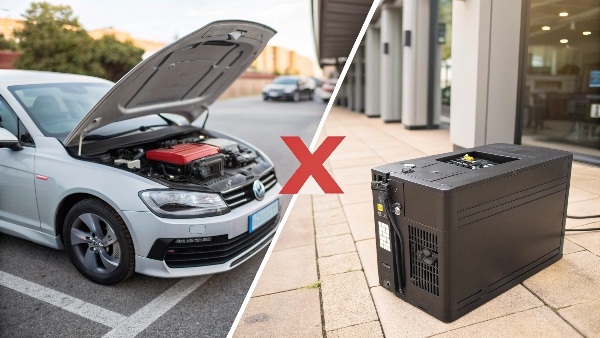
Transition Paragraph:
As an engineer at Daopulse, I see how different batteries are designed for very specific jobs. A car starter battery and a UPS battery are as different as a sprinter and a marathon runner. You can't ask one to do the other's job. This same principle of choosing the right tool applies when selecting power systems for critical infrastructure. Lithium UPS have many advantages. When choosing one, you can consider factors like its performance, structure, and protective accessories. Let's explore how to make these critical choices correctly.
When Should You Replace the Battery in Your UPS System?
Your UPS has been protecting your gear for years. But its internal battery doesn't last forever. An old battery can fail silently, leaving you completely unprotected during the next outage.
You should replace a traditional lead-acid UPS battery every 3 to 5 years. A modern Lithium Iron Phosphate (LiFePO4) battery has a much longer lifespan and should be replaced every 8 to 10 years, or when the UPS self-test alerts you.
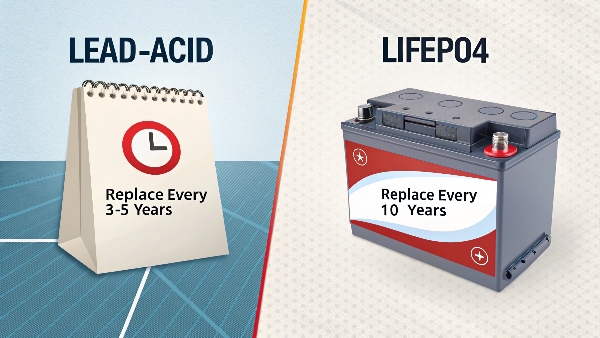
Dive deeper Paragraph:
The replacement schedule depends entirely on the battery's chemistry. Old-style lead-acid batteries degrade with time, heat, and every single use. High ambient temperature can cut their 3-5 year life in half. Most UPS systems run a periodic self-test to check the battery's health, but these can sometimes be missed. This is why a strict replacement schedule is so important for lead-acid. For our clients, this meant a constant cycle of maintenance and replacement costs. This is where LiFePO4 technology changes everything. A LiFePO4 battery can handle thousands of charge cycles instead of just a few hundred. It's also much more resistant to heat. Its 8-10 year lifespan means you install it and forget about it. Over a decade, you would replace a lead-acid battery two or three times. You would only install the lithium battery once. This makes the total cost of ownership much lower, which is a huge benefit for our system integrator clients managing large projects.
What Happens if I Use a 200Ah Battery With a 100A BMS?
You're building a power system and want maximum runtime. So you pair a big 200Ah battery with a 100A BMS. You think you're getting more capacity, but you're actually creating a serious bottleneck.
The system will be limited to the BMS's 100-amp rating. If your equipment tries to draw more than 100 amps of power, the BMS will shut down to protect the battery, even though the battery itself could handle the load.
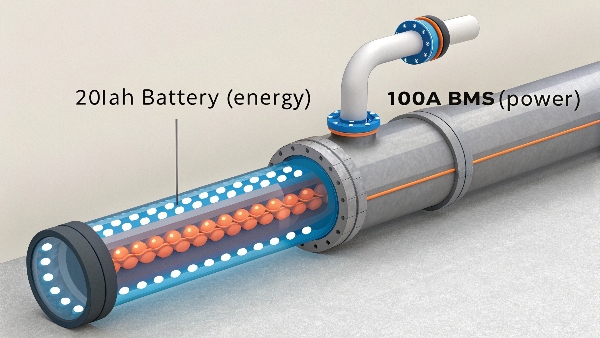
Dive deeper Paragraph:
This is a critical concept I explain to technical directors all the time. You have to understand the difference between capacity (Ah) and power delivery (Amps).
- Capacity (Ah - Amp-hours): This is the size of your energy tank. A 200Ah battery holds twice the energy of a 100Ah battery.
- Power (A - Amps): This is the size of the fuel line delivering that energy. The Battery Management System (BMS) controls this flow.
If you have a massive 200Ah tank but only a 100A fuel line (BMS), you can only draw 100A of power at any given moment. The BMS is the battery's brain and safety system. Its main job is to protect the individual cells from damage. If it detects a current draw higher than its rating, it will instantly cut the power. You get the longer runtime from the 200Ah capacity, but you can't access higher power. This is why we sell integrated systems. We carefully match the BMS to the battery cells and the UPS inverter to ensure every component works in harmony.
Can I Replace My Car Battery With a Lithium Battery?
You love the long life and light weight of lithium batteries. You want to put one in your car. It seems like a simple upgrade, but it's more complex than you think.
Yes, you can, but only with a special lithium "starter" battery made for cars. These are specifically designed to provide high cranking amps and work with a car's charging system. A standard deep-cycle lithium UPS battery will not work.
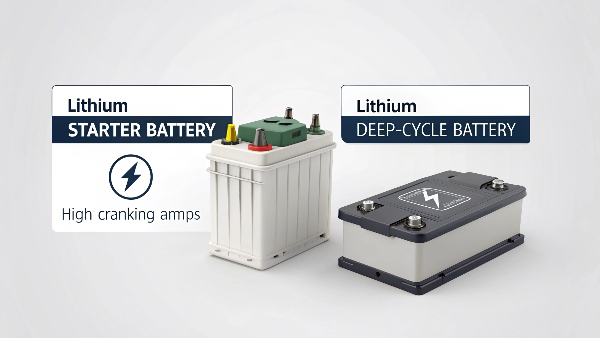
Dive deeper Paragraph:
This goes back to our first point: use the right tool for the job. A car's engine needs a massive jolt of electricity to get started. This is measured in Cold Cranking Amps (CCA)1. A typical lead-acid car battery is built to deliver hundreds of amps for just a few seconds. A deep-cycle lithium battery2, like one for a UPS or an RV, is designed for the opposite. It delivers a low, steady current for hours. If you put a deep-cycle battery in a car, it wouldn't have the power to start the engine. A proper lithium starter battery uses LiFePO4 chemistry3 but has a very powerful, specialized BMS. This BMS is engineered to safely discharge the huge current needed for starting. It also has specific charging logic to work correctly with a car's alternator, which can be very "noisy" and produce uneven voltage. So, while you can upgrade, you must buy a product designed for that exact purpose.
How to Choose a Lithium UPS?
You're convinced. You want the safety, long life, and low-maintenance benefits of a lithium UPS. But with so many models, how do you pick the right one for your needs?
First, calculate the total power (in Watts) of all devices you need to protect. Choose a UPS with a VA rating about 25% higher. Finally, confirm it uses safe LiFePO4 chemistry and has a quality Battery Management System (BMS).
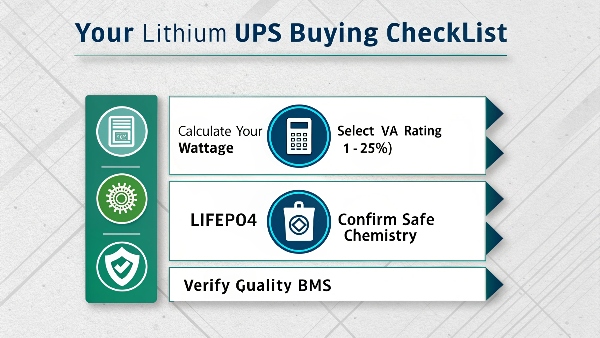
Dive deeper Paragraph:
As my insight stated, choosing the right lithium UPS comes down to three areas: performance, structure, and protection. Let's look at each.
- Performance (Sizing): Add up the Watts of every device you will plug into the UPS (e.g., PC 300W + Monitor 50W + Router 10W = 360W). Because of something called "power factor," the VA rating needs to be higher than the Watt rating. A simple rule is to take your total Watts and add 25-40%. So for 360W, you would look for a UPS around 500VA or higher.
- Structure (Chemistry): Not all lithium is the same. We exclusively use Lithium Iron Phosphate (LiFePO4). It is the safest, most stable, and longest-lasting lithium chemistry available for UPS applications. It's not prone to the thermal issues seen in other types.
- Protective Accessories (The BMS): The Battery Management System is the most vital component. A cheap UPS might have a very basic BMS. A quality UPS from a dedicated manufacturer like us has an advanced BMS that actively balances the cells and protects against over-voltage, under-voltage, short circuits, and high temperatures. This is what guarantees the 10-year lifespan and the safety of your investment.
Conclusion
Always use a battery for its specific job. Choose the right size, confirm it uses safe LiFePO4 chemistry, and ensure it has a quality BMS for maximum protection and value.
-
Understanding CCA is crucial for selecting the right battery for your vehicle. Explore this link to learn more about its significance. ↩
-
Discover the unique features of deep-cycle lithium batteries and their applications, which can help you make informed choices. ↩
-
Learn about LiFePO4 chemistry and its advantages for battery performance, ensuring you choose the best technology for your needs. ↩

